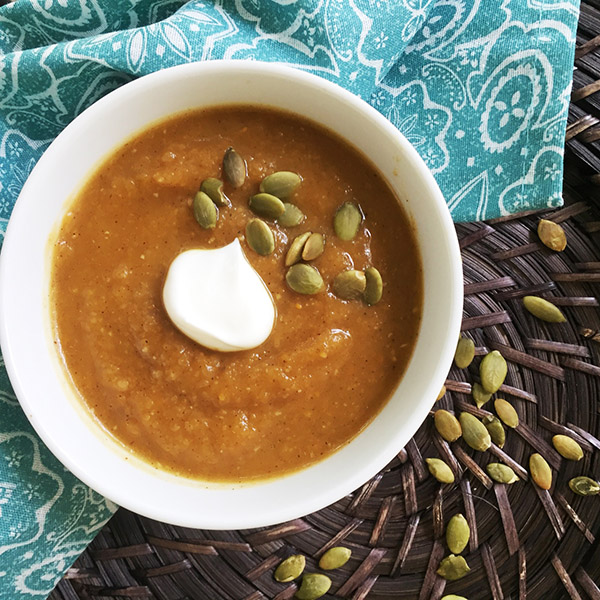Latest News
Diet & Nutrition
Recipe corner - savory pumpkin soup and autumn-spiced pumpkin seeds
Sep 29, 2017

When selecting that perfect pumpkin to make your jack-o'-lantern, pick up another one to eat. Pumpkin can pump up nutrition in your meals. The colorful orange flesh comes from beta carotene, a plant pigment which converts to Vitamin A in our bodies. Beta carotene acts as an antioxidant to help prevent some cancers and promotes heart health. It’s also important for healthy skin and eyes, plus keeps our immune system strong.
Pureed pumpkin can be added to cooked cereals, smoothies and savory foods like chili, soup and sauces. It can replace oil, butter or margarine in baked goods like cakes, muffins and brownies to reduce fat. Fresh pumpkin isn’t sweet, but it can be used in desserts and my favorite seasonal spread, pumpkin butter.
Canned pumpkin puree is readily available in stores. Be sure you’re not purchasing canned pumpkin pie filling which has added sugar and spices. Here’s one way to make fresh pumpkin puree.
Start with a pie pumpkin, which is smaller and easier to cook. Wash and rinse before cutting. Remove the stem and cut the pumpkin in half from top to bottom. Scoop out the pulp and seeds and save to roast as a snack.
Place the pumpkin halves in a microwaveable dish, cut side up. (You may need to cook the halves separately). Add 1 inch of water to the dish, cover and cook on high for 15 minutes. As microwaves vary, you may need to cook longer. It’s ready when the flesh is soft, and can be easily removed from the skin. While still warm, place in a large bowl and puree using an electric mixer.
Pumpkin seeds are a good source of phosphorus, magnesium and manganese-minerals that promote strong bones. They’re a good plant-based source of zinc, which plays a role in healthy immune function. Like the pumpkin flesh, the seeds are a good source of antioxidants, specifically several forms of vitamin E. They’re also provide protein and, when eaten in the shell, fiber.
Enjoy pumpkin season with these two recipes inspired by ones from the American Institute for Cancer research, www.aicr.org.
Savory pumpkin soup
Your choice of pumpkin puree can change the color of the soup. Fresh pumpkin is a golden yellow color while canned is a brownish-orange. Both types provide similar nutrients.
Makes 5 servings (about 1 cup each)
Ingredients:
- 2 tablespoons olive oil
- 2 teaspoons ground cinnamon
- ¾ cup chopped onion
- ½ cup chopped carrot
- ¼ cup chopped celery
- 2 tablespoons fresh grated ginger
- 1 tablespoon minced garlic
- ½ teaspoon salt
- 1/8 teaspoon ground pepper
- 1 can (15 ounces) pumpkin (or 2 cups fresh pumpkin puree)
- 3½ cups low sodium chicken stock
- Low-fat sour cream, as garnish (optional)
- Toasted pumpkin seeds as a garnish (optional)
In a medium saucepan, heat olive oil over medium-high heat. Add cinnamon, onions, carrots, celery, ginger, garlic, salt and pepper to the pan. Sauté for 3-4 minutes, stirring occasionally.
Stir the pumpkin into the vegetables. Add chicken stock and bring to a boil. Reduce to a simmer, cover, and cook for 15 to 20 minutes, or until the vegetables are soft.
Remove the soup from the heat and process in batches in a blender or food processor, until smooth. Garnish individual servings with a dollop of low-fat sour cream or toasted pumpkin seeds, if desired.
Nutrients per serving: 111 calories, 3 grams protein, 6 grams total fat, 11 grams carbohydrate, 4 grams fiber, 437 milligrams sodium.
 Toasted pumpkin seeds with autumn spices
Toasted pumpkin seeds with autumn spicesUse fresh seeds from your jack-o'-lantern (the shells are edible), or purchase hulled ones from the grocery store. If using fresh, place in a colander and rinse to remove pulp. Lay on a pan lined with parchment or wax paper and let dry overnight, then toast for recipes.
Makes 8 servings (2 tablespoons each)
Ingredients:
- Nonstick cooking spray
- 1 cup pumpkin seeds, hulled (or fresh as prepared above)
- 1 tablespoon olive oil
- 1 tablespoon, plus 1 teaspoon dark brown sugar
- 1 teaspoon ground ginger
- ½ teaspoon ground cinnamon
- 1/8 teaspoon cloves
- ½ teaspoon paprika
- 1/8 teaspoon salt
- 2 teaspoons water
Preheat oven to 350 degrees F. Lightly coat a baking sheet with nonstick cooking spray, or line with parchment paper or aluminum foil. Spread seeds on pan in a single layer, and toast in the oven for 10 minutes.
While seeds are toasting, in a small skillet, whisk together oil, brown sugar, ginger, cinnamon, cloves, paprika, salt and water. Heat over medium heat, stir to combine ingredients.
Remove seeds from the oven and pour into the skillet with the spice mixture. Stir to coat seeds evenly, cooking about 5 minutes. Return seeds to the baking sheet, and bake for about 10 minutes or until crisp.
Remove pan from oven and let seeds cool. Gently loosen from baking sheet with a spatula. Some seeds will stick together but can be easily broken apart. Enjoy, or store at room temperature in a tightly covered container.
Approximate nutrients per 2 tablespoons seeds, hulled (made without the shell): 175 calories, 9 grams protein, 13 grams fat, 6 grams carbohydrate, 1 gram fiber, 160 milligrams sodium.

Recipes provided by Mary-Jo Sawyer, R.D., registered dietitian in the Outpatient Nutrition Clinic at VCU Health.
Written by: Massey Communications Office
Related News
Community Engagement & Health Equity, Center News & Funding, Prevention & Control, Diet & Nutrition
2024 Massey seed grant recipients grow community-led health initiativesMay 28, 2024
Prevention & Control, Diet & Nutrition
Summer safety: Can grilled meats produce cancerous chemicals?Jun 29, 2023
Research, Clinical, Community Engagement & Health Equity, Center News & Funding, Prevention & Control, Diet & Nutrition, Technology
Commonwealth celebrates Massey Cancer Center’s comprehensive designation: “If you didn’t know about Massey—now you know”Jun 9, 2023

Get access to new, innovative care
Treatments in clinical trials may be more effective or have fewer side effects than the treatments that are currently available. With more than 200 studies for multiple types of cancers and cancer prevention, Massey supports a wide array of clinical trials.

Find a provider
Massey supports hundreds of top cancer specialists serving the needs of our patients. Massey’s medical team provides a wealth of expertise in cancer diagnosis, treatment, prevention and symptom management.
